With the arrival of the rainy season, the Centre for Health Protection urges members of the public to stay alert to the threat of dengue fever and to take appropriate measures to reduce mosquito breeding.
Travellers to dengue endemic places should take appropriate precautions to prevent mosquito bites.
The primary preventative measure to reduce dengue infections is the control of mosquito populations.
Because the transmission of dengue requires mosquitoes as vectors, the spread of dengue can be limited by reducing mosquito populations.
What can people at risk of dengue infections do to reduce the size of mosquito populations?
One prac-tical and recommended environmental management strategy is to eliminate unnecessary container habitats that collect water (such as plastic jars, bottles, cans, tires, and buckets) in which Aedes aegypti can lay their eggs (Figure 1).
This strategy is called source reduction.
When container habitats are removed and water storage containers are covered with a fine mesh to prevent mosquitoes from getting inside them, mosquitoes have fewer opportunities to lay eggs and cannot develop through their aquatic life stages.
Source reduction can be effective when performed regularly, especially when members of a community are mobilized and educated about vector control.
Environmental management initiatives can also include major changes in a community, such as installing water systems with direct connections to residences and replacing wells and other water-storage containers, which can be mosquito-breeding habitats.
Smaller-scale environmental changes can also be effective.
For example, mosquito populations can be reduced when all members of a community clear blocked gutters and street drains and keep their yards free of containers with standing water.
Any open containers should be emptied and cleaned each week to eliminate mosquito eggs and larvae.
These efforts can reduce the number of mosquitoes living in an area.
What other measures can members of a community take to reduce mosquito populations?
Community-based ap-proaches must go hand in hand with educational initiatives that teach people about mosquito vectors and the risks of having mosquito-breeding habitats near their homes.










